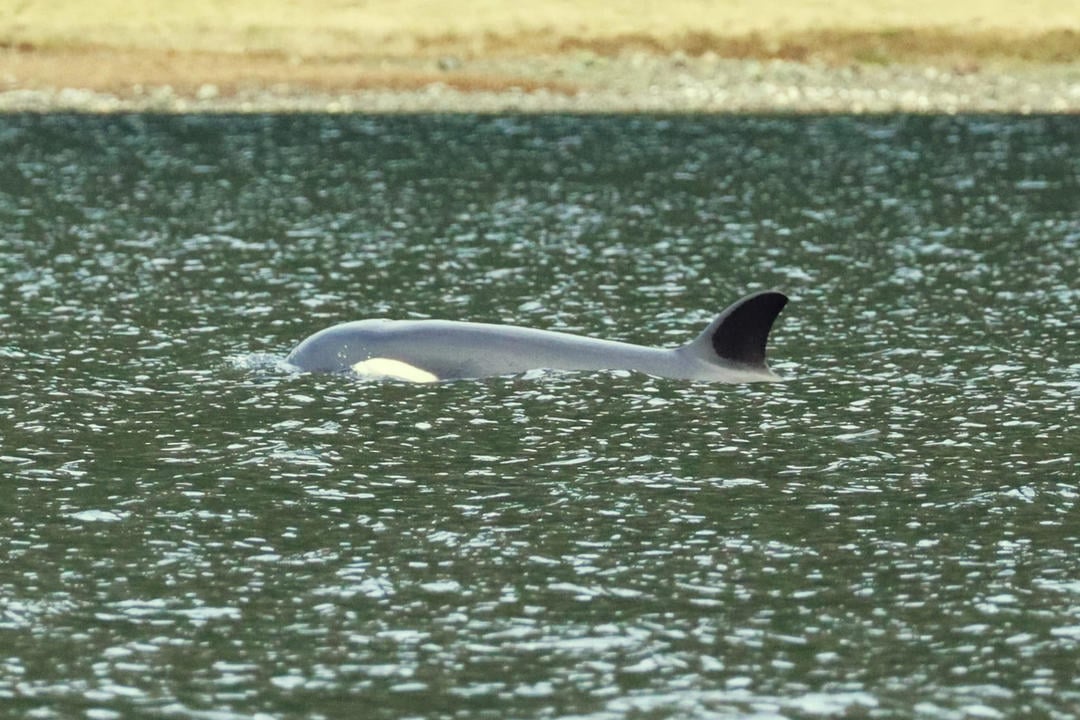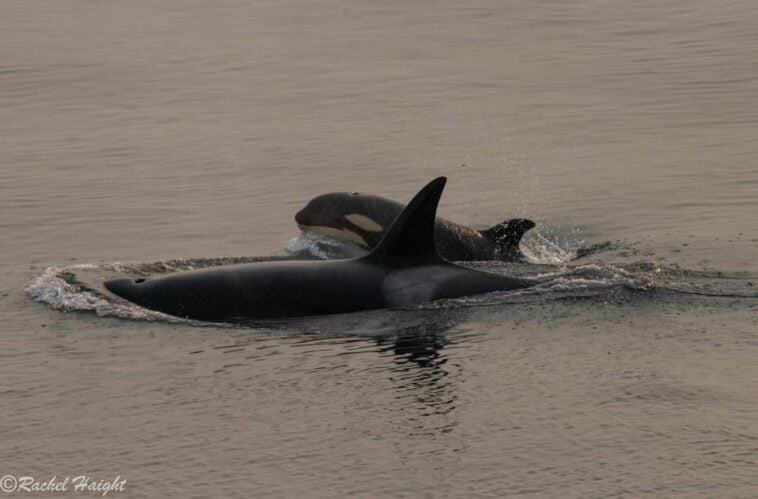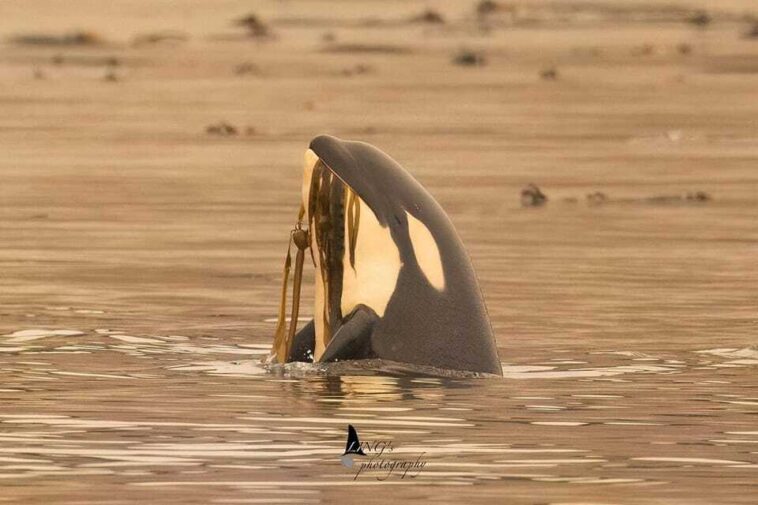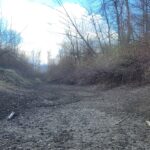In a remote lagoon on Vancouver Island, the saga of a stranded orca calf named Kwiisahi?is or Brave Little Hunter by the Ehattesaht First Nation, has captivated the hearts and minds of West Coasters.
Rescue efforts to remove her from the lagoon near Zeballos are now on pause as of Friday April 12. The young orca has been trapped there since March 23, when her pregnant mother became beached and later drowned. A rescue team composed of whale experts, Fisheries and Oceans Canada (DFO) representatives, and Nuchatlaht and Ehattesaht First Nations, has been working around the clock since on a capture-and-release plan to reunite the young calf with her family pod in the ocean.
The carefully-planned rescue was called off after a failed attempt on Friday to capture Kwiisahi?is in the deep waters of the lagoon. “We were able to get her real close, but she’s catching on to us, so it’s likely our current approach is not going to work,” Paul Cottrell with Fisheries and Oceans Canada said to Global News.
The team is now going back to the drawing board for another tactic to coax the calf out. Vancouver Aquarium officials on site say the orca continues to look healthy and has maintained her body weight. “We’re going to be planning the next couple of days to take that next step to look at different options,” Cottrell said.
Zeballos Inn posted over the weekend that the rescue crew appeared to have left for a few days to rest and regroup. As of April 14, the Inn posted “There was one boat in the lagoon and I’m not sure what they were doing. Other than that it’s a quiet Sunday here.
Let’s hope this next attempt to rescue her works and is done in a timely fashion.”
“This will be a very dangerous and extremely difficult task for the rescue team but they are putting in the time to get everything organized and properly prepared.”
Zeballos Inn on Facebook
On April 11, Zeballos Inn posted on Facebook that the town was “buzzing” as large machinery had arrived to prepare the site to capture Kwiisahi?is in a net known as a ‘hukilau,’ an ancient Hawaiian fishing method. The expert team planned to then transfer her to a sling via a crane, load her onto another truck to transport her to a second site, where she would be lifted onto a boat and then released into the ocean to find her relatives as they pass through the area.
“This will be a very dangerous and extremely difficult task for the rescue team but they are putting in the time to get everything organized and properly prepared,” the Zeballos Inn post said last week, adding that whale experts from the Vancouver Aquarium were present to monitor the transfer. “Your almost home sweetheart, stay strong!” they wrote.
On April 12, roads into Zeballos were closed by the Ehattesaht First Nation, and the public had been asked to stay away to give the rescue team the space needed to complete the delicate mission ahead of them.
“The operation to move Kwiisahi?is to open water and her family is underway this morning,” the Ehattesaht First Nation said to CBC on Friday. “The team assembled at 5 a.m. and were set off with good hearts and intention for the day’s work,” they added.
“We have ancient stories of our whalers being at sea when their canoes fail, and they are brought back home on the back of a killer whale. Maybe this is a modern story but in reverse.”
Ehattesaht First Nation
The Ehattesaht First Nation has been working closely with DFO on the evacuation plan to save Kwiisahi?is and is providing equipment and funds to make it happen. “I’m trying to help people understand a perspective of where we are in this crossroads of actually having meaningful deliberations for the sake of the whale or even whales,” said Ehattesaht First Nation Chief Simon John to CP24 News. “This is a really important time and a crossroads related to our connections.”
“We have ancient stories of our whalers being at sea when their canoes fail, and they are brought back home on the back of a killer whale. Maybe this is a modern story but in reverse,” the Nation said in an earlier release.
Earlier last week, DFO experts noted the two-year-old orca calf’s colour has begun to change from being in fresh water for so long, but told the public this is not a concerning sign for her overall health. Seal remains were deposited in the lagoon in order to keep her nourished after she was not seen eating, likely because she was still relying on her mother for milk and food.

The rescue team has been working non-stop over the past few weeks attempting to coax the young orca out of the lagoon, though with little success. Due to low tide and a sand bar obstructing her exit out of the lagoon, she has been unable to swim out back to the ocean. Whale experts and local First Nations have tried everything from playing whale call recordings to immersing metal pipes in the water to form a ‘sound wall’ to Indigenous drumming.
Meanwhile, marine biologists have been tracking her family pod, which is being monitored nearby. On March 31, the pod was located roughly 100 miles south in the Barkley Sound and headed north towards the calf.
Last week, we spoke with Jared Towers, Executive Director of Bay Cetology, who offered up his organization’s AI technology to track and reunite the calf with nearby relatives. Bay Ceteology’s innovative program allows users to upload their photos into the database, allowing artificial intelligence to identify the whales, from which researchers can precisely track their movements.
“In many ways it feels as though by coming together for Kʷiisaḥiʔis we are beginning to mourn and heal with this youngster.”
Jared Towers, Executive Director of Bay Cetology
Bay Ceteology posted on Facebook on March 31 that they would be making the AI technology open to anyone who wanted to upload photos to help locate Brave Little Hunter’s family. “Within an hour of making that post on Facebook, we knew exactly where the family was,” he said.
Towers said earlier he felt the calf might be struggling to leave the lagoon because it was still grieving the loss of its mother. “Basically, this little one is telling us it’s not ready to go at this time, and there’s nothing we can do but respect that. The general consensus in the community and among those of us on site is that Kʷiisaḥiʔis is mourning,” he wrote in a Facebook post. “In many ways, it feels as though by coming together for Kʷiisaḥiʔis, we are beginning to mourn and heal with this youngster.”

Follow us on the Skeena Strong Facebook page for all the latest updates on the rescue of Kwiisahi?is a.k.a. Brave Little Hunter.




